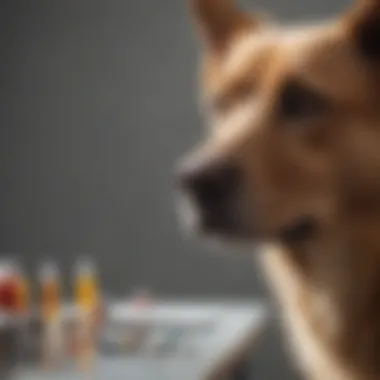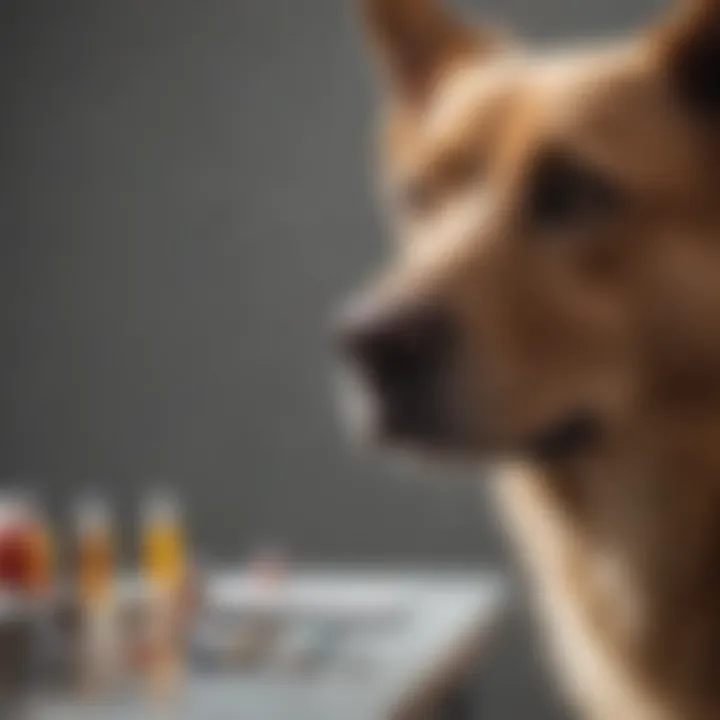Understanding DNA Color Testing for Dogs


Intro
The exploration of DNA color testing for dogs stems from an intricate understanding of genetics. This scientific advancement not only allows breeders to ensure quality in their breeding programs but also aids pet owners in comprehending their dog's lineage. With various genes determining the color and pattern of a dog's coat, these tests can uncover a wealth of genetic information.
Article Overview
Purpose of the Article
The purpose of this article is to elucidate the process of DNA color testing in dogs, providing an understanding of its scientific foundations. It aims to inform breeders, veterinarians, and pet owners about the methodologies involved, the significance of various genetic markers, and the potential implications of DNA analysis. The knowledge gained from these tests facilitates better breeding decisions and enhances the awareness of inherited traits among dog owners.
Relevance to Multiple Disciplines
Genetic testing for dogs intersects multiple fields including veterinary science, genetics, and animal husbandry. Breeders can harness this knowledge to select suitable mating partners based on genetic compatibility. Veterinarians benefit as well, as these insights can guide health checks or tailor healthcare regimes for specific breeds. Furthermore, dog enthusiasts often wish to know their pet's unique genetic makeup and potential behavioral traits, illustrating the topic's broad appeal.
Research Background
Historical Context
The study of canine genetics has matured significantly in recent decades. Initial interests were primarily in breed identification and health assessments. As technology advanced, so too did the understanding of genetic contributions to coat color. The development of commercial DNA testing kits has facilitated widespread access to this knowledge.
Key Concepts and Definitions
Understanding DNA color testing requires familiarity with several genetic concepts:
- Genes: DNA segments that determine traits, including coat color.
- Alleles: Variants of a gene that can influence the physical appearance of a dog’s coat.
- Genotype: The genetic constitution of an individual.
- Phenotype: The observable characteristics, such as coat color and patterns.
"Genetic color tests reveal insights into a dog’s ancestry and the inherited traits of various breeds."
"Genetic color tests reveal insights into a dog’s ancestry and the inherited traits of various breeds."
With these foundational elements defined, one can navigate the complexities of DNA color testing. This specialized approach not only provides answers about a dog's heritage but also contributes to enhancing the quality of breeding and care practices.
Intro to DNA Color Testing for Dogs
DNA color testing for dogs serves as a significant advancement in understanding canine genetics. As we dive deeper into this topic, it becomes evident that such testing can illuminate the complexities surrounding dog coat colors. Knowledge in this area is not merely academic. It has practical implications for breeders and pet owners alike, impacting breeding decisions, and aiding in health assessments. Moreover, these tests allow for informed choices that can enhance the well-being of dogs by identifying potential genetic issues.
Definition and Significance
DNA color testing identifies the genetic makeup of a dog, particularly those genes responsible for the color of their fur. By analyzing specific genes and alleles, owners and breeders can predict the coat color a puppy may inherit. This testing is not limited to aesthetics; it can also provide insight into a dog's ancestry, contributing to a more robust understanding of breed characteristics. The significance of this testing lies in its potential to promote responsible breeding, reduce genetic diseases, and increase awareness of breed-related traits. Thus, it is important for all dog owners who wish to make informed decisions regarding their pets.
Historical Background
The journey of genetic testing in dogs has evolved significantly over the past decades. Early dog breeding practices relied on visual assessments and anecdotal evidence. As the study of genetics advanced, scientists began to unravel the underlying principles of heredity. In the late 20th century, the completion of the dog genome project marked a crucial milestone in the field. This project revealed the genetic structure of various breeds and laid the foundation for DNA testing.
Over time, genetic tests have become more refined. They now include specific tests for coat color that can discern various shades and patterns. Such advancement reflects a growing interest in genetic testing not only for scientific curiosity but also for practical applications in breeding programs. This historical context helps to appreciate how DNA color testing is not just a modern trend but rather the culmination of decades of genetic research.
Genetic Fundamentals of Coat Color
Understanding the genetic fundamentals of coat color is essential in the context of DNA color testing for dogs. This area of study not only informs breeders about the inherited traits of their dogs but also provides pet owners with insights into their companion's genetic background. Knowing the coat color genetics enables better selection during breeding, thereby improving lineage and health outcomes. Furthermore, this information can enrich dog owners' appreciation of their pets, allowing them to understand the underlying genetics that determine their dog's appearance.
Understanding Genes and Alleles
At the core of coat color genetics are genes and alleles. Genes are segments of DNA that carry instructions for producing specific traits. In dogs, coat color is influenced by several genes. Each gene can exist in different forms called alleles. For instance, one gene might determine whether a coat is brown or black, while another could dictate if the coat is solid or spotted. The various combinations of alleles create the diverse range of colors and patterns seen in dog breeds today.
In genetic terms, alleles can be dominant or recessive. A dominant allele can mask the presence of a recessive one. Therefore, a dog with one dominant allele for a dark coat color and one recessive allele for a light coat may display the darker color. This interplay becomes crucial in predicting the traits of future offspring when two dogs are bred together.


Mechanisms of Inheritance
The mechanisms of inheritance dictate how traits, including coat color, are passed from one generation to the next. The two main principles are Mendelian inheritance and non-Mendelian inheritance.
Mendelian inheritance follows Gregor Mendel’s laws, which state that the alleles segregate during gamete formation and fertilization brings together those alleles. Different combinations will determine each individual dog's traits. Non-Mendelian inheritance, on the other hand, can involve more complex factors such as incomplete dominance, co-dominance, or multiple alleles affecting a single trait. For example, the brindle coat pattern seen in some breeds arises from the interaction of multiple alleles at different loci.
Understanding these mechanisms helps breeders make informed decisions about pairings, which can lead to desired traits in their litters.
Link between Genetics and Appearance
The relationship between genetics and appearance is direct and profound. Coat color is among the most visible traits in dogs, and it serves as an excellent model to study genetic inheritance. Several genes work together to produce the final coat color and pattern. Among these are genes controlling pigmentation, distribution of color, and even texture. An understanding of these genetic linkages can guide breeding strategies.
For instance, the agouti signaling protein gene is vital in determining the intensity and pattern of coat color. Changes in this gene can result in a variety of appearances, from solid colors to intricate markings. By tracing these genetic connections, breeders can predict not just the color, but the quality and uniqueness of a dog’s coat.
"The genetic makeup of a dog provides a window into its appearance and potential health, underscoring the importance of DNA color testing."
"The genetic makeup of a dog provides a window into its appearance and potential health, underscoring the importance of DNA color testing."
The DNA Testing Process
Understanding the DNA testing process is crucial for anyone interested in the genetic profiles of dogs. This section explains the steps involved in obtaining accurate coat color information through DNA analysis. By recognizing the process, breeders and pet owners can appreciate the significance of each phase, from sample collection to result interpretation.
Sample Collection Techniques
When it comes to DNA color testing in dogs, effective sample collection is pivotal. There are several methods to gather genetic material, with the most common being buccal swabs and blood samples.
- Buccal Swabs: This technique involves collecting cheeck cells using a soft swab. It is non-invasive, making it a preferred choice for many dog owners. The swab is gently rubbed against the inner cheeks to gather epithelial cells that contain DNA.
- Blood Samples: For a more thorough analysis, blood extraction may be necessary. A veterinarian typically performs this method, ensuring proper handling and storage of the sample. Blood can provide a more comprehensive genetic profile compared to a swab.
Each method has its advantages, and the choice may depend on the specific requirements of the test or the preference of the pet owner. Efficient sample collection greatly influences the accuracy of the test results.
Laboratory Procedures
After successful sample collection, the next step is laboratory analysis. The samples are typically sent to a genetics laboratory specializing in dog DNA testing. Here, a series of procedures take place:
- DNA Extraction: This initial step involves isolating DNA from the collected samples. Specialized kits are used to break down cell membranes and separate DNA from other cellular components.
- Polymerase Chain Reaction (PCR): This technique amplifies specific DNA segments related to coat color genes. By creating multiple copies of the targeted genetic markers, PCR ensures that there is sufficient material for thorough analysis.
- Genotyping: Following amplification, the laboratory examines the DNA to identify alleles associated with coat color traits. Advanced technology, such as SNP (single nucleotide polymorphism) analysis, is often employed during this stage to determine variations in the genetic code.
These laboratory procedures result in a detailed genetic profile, providing insights into the dog's coat color inheritance.
Interpreting Test Results
After the laboratory completes the analysis, pet owners receive a report detailing the dog's genetic makeup concerning coat colors. Interpreting these results can be complex, but understanding key components is essential.
- Genetic Markers: The report typically includes information about specific genes and alleles related to coat color. Each marker's presence indicates inherited traits that contribute to the dog's appearance.
- Probabilities: Many reports provide probabilities associated with certain coat colors. For instance, a dog might have a 75% chance of producing a specific coloration in its offspring based on its genetic makeup.
- Limitations and Considerations: It is important to note that DNA testing does not guarantee specific coat colors in a dog or its offspring. Environmental factors and gene interactions also play significant roles in determining appearance.
"While DNA testing provides valuable insights, it is just one piece of understanding a dog's genetics."
"While DNA testing provides valuable insights, it is just one piece of understanding a dog's genetics."
Applications of DNA Color Testing in Dogs
DNA color testing for dogs has garnered attention for its wide array of applications. This testing holds not only scientific significance but also practical implications for breeders, veterinarians, and dog owners. Understanding these applications can enhance breeding decisions, improve health monitoring, and play a crucial role in pet identification and verification.
Breeding Decisions
One major application of DNA color testing is in making informed breeding decisions. Breeders increasingly rely on genetic testing to understand the color genetics of their dogs. By identifying the specific alleles present in a dog’s genome, breeders can predict potential color outcomes in the offspring. This knowledge can guide them in selecting suitable mating pairs, thereby ensuring that the desired traits are more likely to be passed on. Additionally, it helps avoid unintended breedings that might produce undesirable or unexpected coat colors.
- Helps in choosing mates for dogs based on coat color genetics.
- Reduces risks of genetic defects associated with specific coloration.
- Supports improvement of breed standards and aesthetics.


Data from testing can inform not just color outcomes but also related health concerns. Certain coat colors can be indicative of genetic health problems. Hence, breeders can make more responsible choices that benefit both the dogs and the breed as a whole.
Health Monitoring
Health monitoring is another crucial application of DNA color testing. Genetic tests can inform dog owners about potential health risks associated with certain coat colors. For instance, the genetics underlying various colors can correlate with congenital conditions or predispositions to specific health issues.
Benefits include:
- Early identification of potential health issues.
- Informed decisions regarding preventive healthcare.
- Customized dietary and health plans to address existing conditions.
Moreover, by integrating DNA testing into regular veterinary visits, pet owners can develop a more proactive approach. Tracking genetic health changes over time allows for the personalization of health monitoring strategies. Thus, owners can optimize their dogs' quality of life through tailored care strategies.
Pet Identification and Verification
Pet identification and verification represents a vital application of DNA color testing. The ability to accurately ascertain a dog's breed and lineage via genetic testing is invaluable for various reasons. Many dog owners seek to understand their pet's ancestry, which contributes to bonding and care tailored to breed-specific needs.
Through DNA testing, owners can:
- Verify a dog's breed mix, helping identify traits that influence behavior and health.
- Ensure they are adhering to breed-specific regulations, relevant in many urban areas.
- Potentially increase pet recovery chances if lost or stolen, by providing genetic records for identification.
"Genetic testing opens doors to a wealth of information that can bridge the gap between owners and their canine companions, enhancing mutual understanding."
"Genetic testing opens doors to a wealth of information that can bridge the gap between owners and their canine companions, enhancing mutual understanding."
Ethical and Social Implications
Understanding the ethical and social implications of DNA color testing for dogs is crucial in today's context. The advancements in genetic testing not only affect the science behind dog breeding but also touch on broader societal issues. Factors such as animal welfare, genetic diversity, and responsible ownership come into play when discussing this topic.
Concerns Surrounding Genetic Testing
The use of DNA color testing raises several concerns. First, there is the potential for misuse of information gleaned from genetic tests. Some breeders might rely excessively on these tests, prioritizing certain traits over the overall health and welfare of the breed. This approach can exacerbate the existing problems of inbreeding and genetic disorders in dogs. Moreover, not all genetic tests are created equal. The accuracy and reliability of results can vary widely across different testing services.
Animal rights advocates also raise alarms regarding privacy and consent. While dogs cannot consent in a human sense, questions arise about the decision-making power of breeders and pet owners when utilizing such tests. Ethical frameworks must address whether it's right for owners to make genetic decisions that could affect a dog's future health and quality of life.
"Genetic testing holds great potential, but it also comes with significant responsibilities that breeders and pet owners must recognize."
"Genetic testing holds great potential, but it also comes with significant responsibilities that breeders and pet owners must recognize."
Impact on Breeding Practices
The introduction of DNA color testing has created a seismic shift in breeding practices. Breeders can now make more informed decisions about which dogs to mate based on genetic compatibility. This can enhance desirable traits, improve coat color, and even preemptively address health issues that may arise from certain genetic combinations.
However, this benefit does not come without complications. The reliance on genetic color testing can lead to a narrow focus on aesthetic goals, overshadowing essential health considerations. Some breeders may inadvertently promote a limited gene pool, which can lead to future problems of genetic diversity. This promotes the significance of balancing appearance with genetic health in breeding decisions.
The long-term implications for dog breeds could mean a fundamental change in how breeds are perceived and evaluated. This could create a division between breeders who value genetic testing for its benefits and those who prioritize traditional methods of breeding.
Public Perception and Acceptance
Public perception of DNA color testing is varied. Many dog owners view genetic testing as a valuable resource that empowers them with knowledge about their pets. They appreciate the ability to understand not just the color of their dog's coat, but also the underlying genetic makeup and potential health issues.
On the other hand, there is skepticism. Some pet owners are wary of the science behind DNA testing and question the necessity and ethics of such practices. Concerns about the accuracy of results and the potential for false security can lead to doubt. These mixed feelings raise an important question: how can the industry foster greater transparency and trust?
Education plays a crucial role in shaping public opinion. Awareness campaigns that explain the benefits and limitations of DNA testing can mitigate fears and highlight responsible practices. Engaging with both the scientific community and the general public will encourage a balanced conversation about the implications and applications of genetic testing for dogs.
Limitations and Challenges of DNA Color Testing


When exploring the topic of DNA color testing for dogs, understanding the limitations and challenges is crucial. This knowledge can help pet owners and breeders make informed decisions about the use and application of genetic testing. Recognizing these constraints leads to a more nuanced understanding of the results and their implications.
Scientific Limitations
There are specific scientific limitations associated with DNA color testing. These limitations can hinder the accuracy and reliability of results. One notable issue is the complexity of canine genetics. Coat color is influenced by multiple genes, which often interact in unknown ways. Current tests may not account for all genetic variations and can lead to inconclusive results. Furthermore, some breed-specific traits might not be adequately represented in databases. This lack of representation means that test results may offer limited insights about less common breeds or hybrids.
Another scientific challenge lies in the uncertainty of inheritance patterns. While some color traits follow a straightforward Mendelian inheritance model, others do not. This complexity can lead to unexpected results that might confound breeders' expectations when making pairing decisions.
Accessibility and Costs
Accessibility is another important consideration. Availability of DNA testing services varies by location and provider. Some regions may have limited access to reputable testing facilities. This can lead to delays or even inaccuracies in results if tests are sent far from trustworthy laboratories. Costs also present a barrier. The price of DNA color testing can range significantly based on the provider and the depth of analysis offered. For many pet owners, this cost may be prohibitive, particularly if multiple tests are needed for several dogs. The financial constraints can limit the ability of breeders and owners to utilize these tests effectively.
Variability of Results
Variability in test results is also a significant challenge. Different laboratories may use various methodologies and technologies, leading to inconsistent findings. This variability can undermine trust in the results provided to pet owners and breeders. In some instances, a dog may receive differing results depending on where the DNA test was conducted. Additionally, some dogs may possess traits that are not yet fully understood, further complicating interpretation.
"Understanding the limitations of DNA color testing is as crucial as knowing how to utilize its results. Without this awareness, misunderstanding may lead to poor breeding decisions."
"Understanding the limitations of DNA color testing is as crucial as knowing how to utilize its results. Without this awareness, misunderstanding may lead to poor breeding decisions."
In summary, while DNA color testing can provide valuable insights, it is essential to approach the topic with a critical eye. The scientific limitations, accessibility issues, and variability of results must be carefully considered. This understanding allows breeders and owners to make better-informed decisions.
Future Directions in Dog Genetic Testing
The evolution of DNA color testing and broader genetic testing in dogs is not just a passing trend; it is a complex tapestry of science, technology, and ethical considerations. The future holds promising advancements that could reshape our understanding of canine genetics. Key areas such as emerging technologies and novel research developments will play significant roles in this transformation.
Emerging Technologies
Recent advancements in genomic technologies are reshaping the landscape of dog genetic testing. Several innovative methods are being adopted to enhance the accuracy and efficiency of DNA color testing.
One notable technology is Next Generation Sequencing (NGS). This technique allows for the rapid sequencing of large amounts of DNA, providing a detailed view of genetic variations that affect coat color. NGS enables researchers to detect even subtle genetic markers that traditional testing methods might overlook. As these tools become more affordable, they could become mainstream in veterinary practices.
Moreover, mobile applications and cloud-based platforms are making DNA testing more accessible. Dog owners can collect samples at home and send them directly to labs using pre-paid kits. This could increase participation in genetic studies and enhance the database of canine genetics.
Additionally, machine learning is starting to play a role. Algorithms can analyze genetic data to predict outcomes related to health and appearance more accurately. This integration of artificial intelligence can fine-tune the predictive models used in dog breeding and care.
Potential Research Developments
Research in dog genetics is on the rise, and several potential developments could significantly impact how we understand DNA color testing. One area of focus is the discovery of new genetic loci that influence coat color. As scientists delve deeper into the canine genome, they may uncover additional markers that provide insights into the variations we observe in different breeds.
Investigations into the correlation between coat color and other traits are also likely to emerge. For instance, researchers may examine whether certain coat colors influence behavior or health conditions. These studies could deepen our understanding of the nuances in canine genetics and enhance breeding practices.
Furthermore, there is room for interdisciplinary collaboration. Geneticists, veterinarians, and breeders could work together to develop specific programs that harness genetic testing to promote health-focused breeding. The establishment of revised standards for genetic testing could cultivate responsible breeding practices focused on health and temperament rather than purely aesthetic qualities.
Closure
In this article, we have navigated the complex landscape of DNA color testing for dogs. Understanding this subject is crucial for breeders, veterinarians, and dog owners alike. The insights gained from DNA color testing not only inform on the genetic factors determining coat color but also empower individuals to make educated decisions in breeding and health monitoring.
One of the specific elements covered includes the intricate relationship between genetics and appearance. This relationship helps clarify how certain traits can be predicted and managed through DNA analysis. Another important aspect is the technology used for testing. This technology continues to advance, enhancing the accuracy and reliability of results. Additionally, we highlighted the ethical considerations surrounding genetic testing. It is essential for stakeholders to be aware of these implications to engage in responsible breeding practices that maintain the integrity of dog breeds.
Summary of Key Points
- DNA color testing offers insights into a dog’s genetic makeup, directly correlating with coat color and patterns.
- The testing process involves sample collection, laboratory analysis, and careful interpretation of results.
- Applications of these tests extend to breeding decisions, health monitoring, and unique identification of pets.
- Ethical and social implications demand consideration, shaping public perceptions and breeding practices.
- Emerging technologies and research in the field suggest a promising future for genetic testing in dogs.
Final Thoughts on DNA Color Testing
As we conclude our exploration of DNA color testing, it is clear this field holds significant potential. The ability to understand genetic heritage and predict coat color traits can enhance breeding programs, improve animal health, and assure pet owners of their animal's well-being. Moreover, as technology evolves, we can expect even more refined testing methodologies.
"Understanding the genetic basis of coat color in dogs opens avenues for more responsible breeding and informed pet ownership."
"Understanding the genetic basis of coat color in dogs opens avenues for more responsible breeding and informed pet ownership."
As more studies emerge, the conversation around ethical implications and potential applications will continue to grow, making it imperative for all involved in the canine community to remain engaged and informed.



